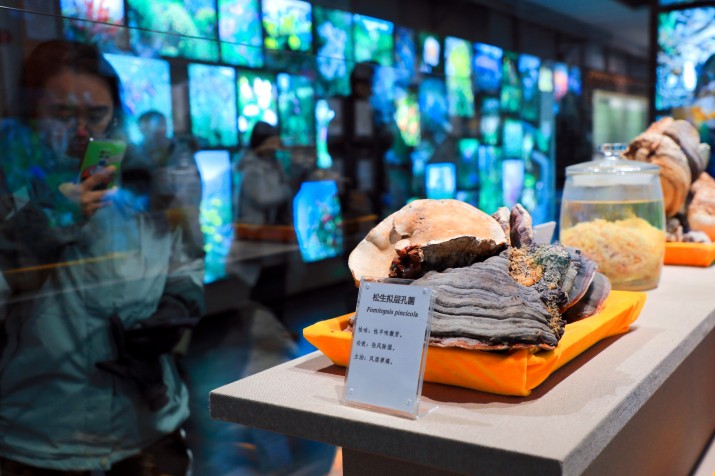| Voice |
| Advancing TCM | |
|
|
 Medical herbs collected from the Altay Mountains on display at an exhibition in Altay Prefecture on December 25, 2024 (VCG)
Xinjiang Uygur Autonomous Region is uniquely positioned to deepen China's cooperation with Central Asian countries in the field of traditional Chinese medicine (TCM). Leveraging its favorable geographical location and abundant resources, it can play a crucial role in advancing the development of healthcare on both sides. Great potential TCM, with its proven effectiveness and affordability, is increasingly gaining acceptance among local populations. Central Asia is rich in natural medicinal resources and the use of herbal medicine has a long history in the region. Herbal therapies are widely favored for their ability to prevent and treat diseases. In recent years, the demand for TCM products and services in Central Asia has grown steadily, with acupuncture, cupping and guasha—a traditional Chinese scraping technique aimed at relieving pain—becoming increasingly popular in local healthcare practices. However, due to geographical, economic and infrastructural challenges, the level of healthcare services in many Central Asian countries remains relatively low. Traditional medicine is still used there in the form of folk remedies. Since TCM education in their home countries is insufficient to meet the need for cultivating highly qualified physicians, many students from Central Asian countries have been coming to China to study TCM through initiatives under the Shanghai Cooperation Organization and Chinese government scholarships such as the Silk Road Scholarship Program. At the same time, as local governments in these countries are increasingly supportive of using TCM to treat some diseases, there is great potential for the adoption of TCM in the region. Xinjiang is home to many wild, native medicinal plant species, providing a unique advantage for its TCM cooperation with Central Asian countries. The region also has optimal conditions for cultivating a wide range of medicinal plants, with large-scale cultivation already established for major herbs such as licorice, safflower and goji berries. Licorice is a widely used herb in TCM, renowned for its ability to relieve cough and harmonize other herbs. Safflower is used primarily to invigorate blood circulation, while goji berries are highly valued for their nourishing and restorative properties. Xinjiang stands out in promoting standardized cultivation, large-scale operation and industrial development of these herbs. In addition to its natural resources, Xinjiang shares long-standing cultural and historical ties with Central Asian countries, particularly with Kazakhstan, Kyrgyzstan and Tajikistan, constituting a great foundation for expanding TCM cooperation in the region. Substantial progress In May 2024, a conference on the high-quality development of TCM in Xinjiang outlined strategies to promote TCM culture, focusing on establishing a medical service hub. The conference emphasizes leveraging Xinjiang's resources, strategic location, and industrial strengths to enhance the TCM industry. The conference also highlighted the need to seize major opportunities to strengthen TCM-related exchanges and cooperation with Central Asian countries, boosting the industry's economic and social contributions. As part of the plan, Xinjiang will work on the construction of joint laboratories and research centers with academic institutions in Central Asian countries. While Central Asian countries boast abundant medicinal herbal resources, their ability to research and develop herbal medicines faces limitations due to challenges in processing raw materials and clinical application. The establishment of joint institutions will help pool resources of both sides to develop breakthroughs in TCM research and facilitate the shared use of key medicinal plant resources. Additionally, this collaboration will assist in the cultivation of high-caliber research teams and personnel, which will be essential for supporting the high-quality development of the TCM industry in Central Asia. Central Asia's pharmaceutical industry faces challenges, such as an insufficient supply of finished medicines and slow development in the medicinal plant sector. Xinjiang can contribute significantly by nurturing large, innovative TCM enterprises and developing reputable brands to enhance the quality and market competitiveness of local products. By implementing supportive policies, Xinjiang can also encourage its companies to invest in TCM production facilities in Central Asian countries, thereby promoting the growth of the medicinal plant industry in the region. Xinjiang can share educational resources and collaborate on TCM education and training programs with Central Asian countries. Many medical institutions in Central Asia face challenges with outdated teaching equipment and limited resources. By offering training programs for TCM practitioners and establishing joint projects with local medical schools in Central Asian countries, Xinjiang's TCM higher education institutions can contribute their expertise. Additionally, sending skilled teachers for cross-border teaching activities and providing online education platforms can facilitate knowledge and resource sharing, benefiting both sides. Xinjiang can also tap into the nation's pairing-up assistance program to strengthen cooperation with Central Asian countries. (Under China's paring-up assistance program, 19 provinces and municipalities across China have provided all-round support for Xinjiang—Ed.) Through the program, Xinjiang can introduce more advanced TCM techniques and management models to Central Asian countries, addressing the healthcare needs of local populations. Establishing TCM service centers focused on improving technical skills, training personnel and enhancing the management of medical services will create a world-class platform for promoting TCM culture across Central Asia, assisting in providing high-quality healthcare services to the people of the region. To promote a wider knowledge of TCM culture in Central Asia, Xinjiang can focus on creating more opportunities for exchange and cooperation. By utilizing platforms like the China-Eurasia Expo, Xinjiang aims to foster stronger partnerships between its medical institutions and enterprises and those in Central Asia within the TCM field. Organizing regular events, such as TCM culture festivals and seminars in Central Asian countries, can increase local awareness and appreciation of TCM practices. These initiatives aim to make TCM a valuable cultural bridge, encouraging mutual understanding and bringing the people of China and Central Asia closer together. Feng Jianghua is an associate professor at Xinjiang Normal University's Business School. Shen Haitao is a professor at the College of Life Sciences, Shihezi University. The article was first published in Xinjiang Daily |
|
||||||||||||||||||||||||||||||
|